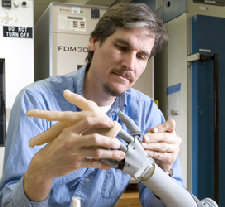Homepage
Bibliography/Links
How it works
NEXT: Future Technology
Why are scientists looking to use living muscles in replacement of motors in prosthetics? Muscles have excellent functional characteristics. For example, you can get 50 watts per kilogram of muscle tissue. (7) Muscles are quiet especially compared to motor actuators. Muscles are adaptive and grow stronger from use and weaker from disuse. They are also scalable, coming in all sizes. Furthermore, electic motors have limited battery life and often lead to heavy, bulky limbs.
To test this hypothesis, researches at MIT built a swimming robot actuated by living muscle. The muscles on each side were electronically stimulated to move the tail. The robot swam for several hours, and had the ability to swim forward, backward, turn and stop. This research is still in its infancy and it will be many years before living muscle will be used as actuators. In the mean time, DARPA's first prototype will be battery-powered, and future versions may rely on fuel cells or small cartridges of hydrogen peroxide-which could be jettisoned and replaced almost as easily as a flashlight battery. The second prototype weighs 3.2 kg and can manipulate 22 kg, which is unprecedented for robotic arms.(8)
Testing living muscle tissue
as actuators for electronic devices
A living muscle actuator!
http://www.newscientisttech.com/channel/tech/robots/dn450
http://www.jpl.nasa.gov/news/features-pri nt.cfm?feature=492
One of DARPA's (APL) prototype prosthetic arms http://www.jhuapl.edu/





